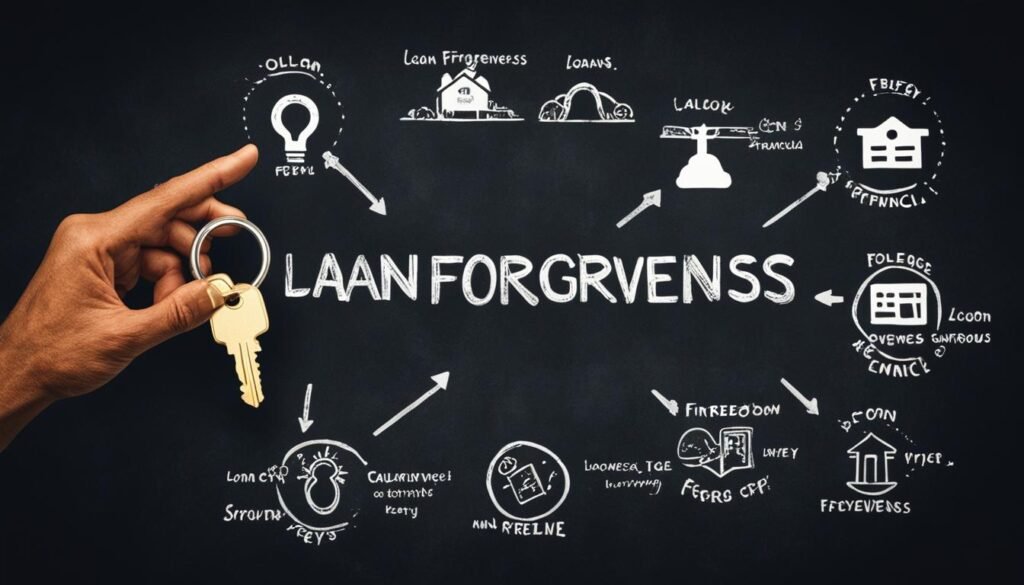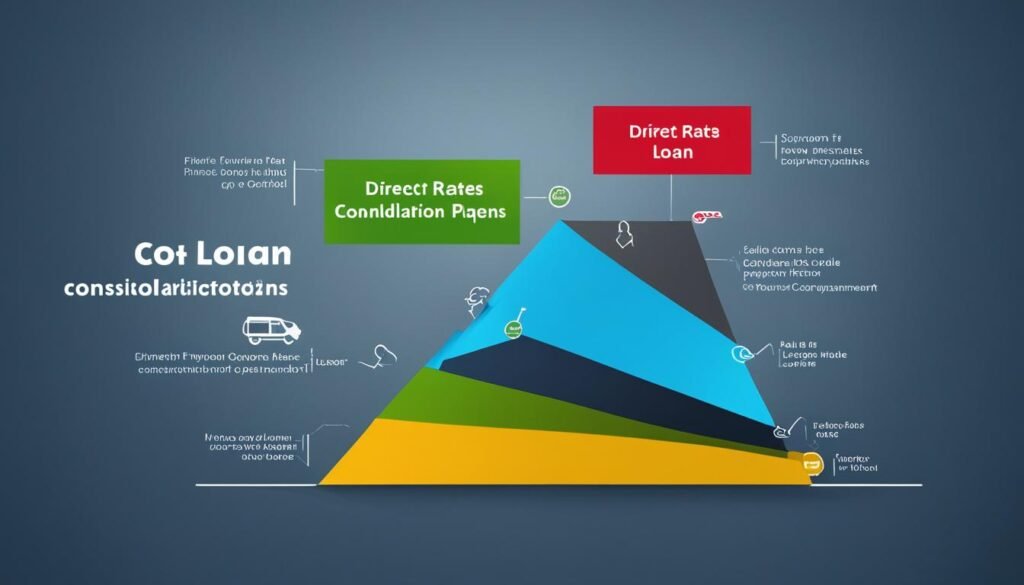If you’re struggling to manage multiple federal education loans, a direct consolidation loan could be a viable solution. Consolidation allows you to combine two or more loans into a single loan with a fixed interest rate based on the weighted average of the consolidated loans. This simplifies the repayment process by reducing the number of monthly payments you need to make.
However, before jumping into consolidation, it’s important to understand the pros and cons involved. Consolidating your loans may offer benefits such as lower monthly payments, the convenience of a single monthly payment, access to different repayment options, eligibility for loan forgiveness programs, and a fixed interest rate that may be lower than the rates on your original loans.
On the other hand, there are potential drawbacks as well. Consolidation could result in paying more interest over the life of the loan, as well as the loss of certain benefits associated with your original loans, such as grace periods and credit for prior loan payments towards loan forgiveness requirements.
Key Takeaways
- A direct consolidation loan combines multiple federal education loans into one loan with a fixed interest rate.
- Consolidation can lower your monthly payments and make repayment more manageable.
- Benefits of consolidation include access to different repayment options and eligibility for loan forgiveness programs.
- Consider the potential loss of benefits and increased interest before choosing to consolidate.
- Reach out to the federal student aid information center for guidance on loan forgiveness options.
Understanding Direct Consolidation Loans
Direct consolidation loans offer a solution for borrowers looking to simplify their federal education loans. With this option, multiple federal loans can be combined into a single loan that is managed by the U.S. Department of Education. However, it’s important to understand the process, eligibility requirements, and potential drawbacks before deciding to consolidate.
Consolidating loans can provide several benefits, including:
- Lower monthly payments: One of the primary advantages of loan consolidation is the potential to reduce monthly payments. By combining multiple loans into a single loan, borrowers can often secure a more manageable payment amount.
- Access to loan forgiveness options: Consolidating student loans may make borrowers eligible for various loan forgiveness programs, such as the Public Service Loan Forgiveness (PSLF) program. These programs can provide significant financial relief over time.
However, there are important factors to consider before pursuing a direct consolidation loan:
- Loss of benefits: When loans are consolidated, certain benefits associated with the original loans may be lost. For example, borrowers who consolidate their loans may no longer be eligible for interest rate discounts or other repayment incentives.
- Increased interest over the life of the loan: While consolidating loans can lead to lower monthly payments, it’s important to consider the long-term impact. Consolidation may result in increased interest charges over the life of the loan, potentially leading to higher total repayment costs.
It’s crucial for borrowers to carefully evaluate their financial situation, goals, and specific loan terms before deciding to consolidate. Each borrower’s circumstances are unique, and what works for one individual may not be the best option for another.
“Direct consolidation loans offer the convenience of simplifying monthly payments and potentially lowering the payment amount. However, it’s crucial to weigh the benefits against the potential drawbacks to make an informed decision.”
Direct Consolidation Loan Process

Applying for a direct consolidation loan is a straightforward process managed by the Federal Direct Student Loan Program. Borrowers have two options to apply for loan consolidation: online or through a mail-in application.
When considering consolidation, it’s crucial to carefully evaluate the benefits associated with your original loans and how a new loan will impact your repayment terms and interest rates. By understanding the direct consolidation loan process, you can make an informed decision about consolidating your loans.
The application for a direct consolidation loan is free. Once approved, you’ll have the convenience of a single monthly payment on your consolidated loan. This simplifies your loan management and allows for better financial planning.
Direct Consolidation Loan Application Methods:
- Online Application: Visit the Federal Student Aid website to complete the online direct consolidation loan application. This fast and convenient method allows you to provide the necessary information and submit your application electronically.
- Mail-In Application: If you prefer a physical application, you can download the application form from the Federal Student Aid website and mail it to the provided address. It’s essential to double-check that you’ve included all required documents.
Considerations Before Applying:
Before submitting your direct consolidation loan application, take the time to thoroughly consider the following:
- The potential loss of benefits associated with your original loans, such as interest rate reductions or principal rebates.
- The impact of a consolidated loan on your repayment terms and interest rates over the life of the loan.
By carefully weighing these considerations, you can make an informed decision about consolidating your loans and ensuring it aligns with your financial goals.
Direct Consolidation Loan Application Checklist:
| Required Documents | Details |
|---|---|
| Loan information | Gather the details of each loan you wish to consolidate, including lender information, loan amounts, and current repayment status. |
| Personal information | Provide accurate personal details, including your social security number, contact information, and driver’s license number (if applicable). |
| Educational background | State your educational history, including the institutions you attended and the degrees or certifications you obtained. |
| Income information | Include your current employment details and disclose any additional sources of income, such as investments or rental properties. |
| Loan servicer details | Provide information on your current loan servicers, which can be found on your loan statements or by contacting your loan servicers directly. |
| Employment certification (for PSLF) | If you’re pursuing loan forgiveness through the Public Service Loan Forgiveness (PSLF) program, complete the Employment Certification form and submit it with your application. |
Once you’ve gathered all the required documents and completed the application, carefully review it for accuracy before submission. Remember to keep copies of all documents for your records.
If you have any questions or need assistance during the direct consolidation loan process, reach out to the Federal Student Aid Information Center for guidance and support.
Pros of a Direct Consolidation Loan
Consolidating your loans into a direct consolidation loan offers several advantages that can help you manage your finances with greater convenience and flexibility. Here are the pros of opting for a direct consolidation loan:
- Lower Monthly Payments: With a direct consolidation loan, you can potentially reduce your monthly payments, making it more manageable to meet your financial obligations.
- One Monthly Payment: Instead of juggling multiple loan payments, consolidating your loans allows you to make just one monthly payment. This streamlines the repayment process and saves you from tracking different due dates.
- Different Repayment Options: Direct consolidation loans provide access to a range of repayment options. You can choose a plan that best suits your financial circumstances and goals, such as income-driven repayment or extended repayment.
- Access to Loan Forgiveness Options: By consolidating your loans, you may become eligible for various loan forgiveness programs. These programs can potentially eliminate a portion or all of your remaining loan balance, reducing your overall debt burden.
- Fixed Interest Rate: A direct consolidation loan comes with a fixed interest rate that may be lower than the rates on your previous loans. This offers stability and predictability, making it easier to budget your monthly expenses.
Consolidating your loans provides not only financial ease but also the potential for long-term savings and simplified loan management. The next section will explore the drawbacks of a direct consolidation loan to help you make an informed decision.
Cons of a Direct Consolidation Loan

While there are benefits to consolidating your student loans, it’s important to consider the potential drawbacks before making a decision. Here are some cons of a direct consolidation loan:
- You could pay more interest over the life of the loan: When you consolidate your loans, the new loan will have a weighted average interest rate. While this can help simplify your monthly payments, it may result in paying more interest over the long run compared to keeping your loans separate.
- No grace period: Unlike some individual loans, a direct consolidation loan does not come with a grace period. This means that you will need to start making payments immediately after the consolidation loan is disbursed.
- Prior loan payments don’t count toward loan forgiveness requirements: If you’ve been making payments on your individual loans with the goal of qualifying for loan forgiveness, consolidating them may reset the clock. Prior payments made on your original loans may no longer count toward the requirements for loan forgiveness.
- You may lose some benefits: Certain benefits associated with your original loans, such as interest rate discounts or loan forgiveness programs specific to those loans, may not carry over to the new consolidated loan. It’s important to carefully review the terms and benefits of your original loans before deciding to consolidate.
Considering these potential drawbacks, it’s crucial to weigh the pros and cons of a direct consolidation loan to determine if it aligns with your financial goals and circumstances.
Loan Forgiveness and Assistance

When considering a direct consolidation loan, borrowers should also explore the loan forgiveness programs that are available. These programs provide opportunities for borrowers to have a portion or even the entirety of their remaining principal and interest on a student loan cancelled.
One of the loan forgiveness programs available to borrowers with direct consolidation loans is the Teacher Loan Forgiveness Program. This program is designed specifically for teachers who have been working in a low-income school or educational service agency for a certain number of years. Through this program, eligible teachers can have a portion of their federal student loans forgiven.
Another loan forgiveness program to consider is the Public Service Loan Forgiveness (PSLF) program. The PSLF program offers loan cancellation to individuals who work full-time in a qualifying public service job and make 120 qualifying payments towards their student loans. After meeting these requirements, borrowers may be eligible to have the remaining balance of their loans forgiven.
To learn more about loan forgiveness options, borrowers should contact the Federal Student Aid Information Center. This resource can provide comprehensive information and guidance on the available loan forgiveness programs, eligibility criteria, and application process.
It’s important for borrowers to explore all available options to make an informed decision regarding their student loans. Loan forgiveness programs can provide significant relief and help borrowers manage their debt more effectively.
What Loans Can Be Consolidated into a Direct Subsidized Consolidation Loan?

Borrowers have the option to consolidate various types of federal student loans into a direct subsidized consolidation loan. This includes:
- Direct subsidized and unsubsidized loans
- Federal Family Education Loans (FFEL)
- Perkins loans
It is crucial to identify the specific loans you want to consolidate and ensure that they are eligible for consolidation before proceeding with the application process.
What Is the Interest Rate on a Direct Consolidation Loan?

When considering a direct consolidation loan, it’s essential to understand the interest rate associated with it. The interest rate on a direct consolidation loan is determined by taking the weighted average of the interest rates on the loans being consolidated. This average is then rounded up to the nearest one-eighth of a percent.
It’s important to note that the interest rate on a direct consolidation loan is fixed. This means that the rate will remain the same throughout the lifespan of the loan, providing stability and predictability in repayment.
When deciding whether to consolidate your federal student loans, it’s crucial to consider any interest rate discounts or benefits associated with the original loans. Some loans may offer interest rate reductions or incentives for on-time payments, which could impact the overall interest rate on the consolidated loan.
| Loan Type | Interest Rate |
|---|---|
| Loan A | 4.5% |
| Loan B | 5.2% |
| Loan C | 6.1% |
| Consolidated Loan | 5.0% |
For example, let’s say you have three loans with interest rates of 4.5%, 5.2%, and 6.1%. The weighted average of these rates is 5.2%. However, after rounding up to the nearest one-eighth of a percent, the interest rate on the consolidated loan would be 5.0%.
By consolidating your federal student loans, you can simplify your repayment process and potentially benefit from a lower, fixed interest rate. However, it’s important to carefully evaluate the individual interest rates of your loans and determine whether consolidation is the right choice for your financial situation.
Does Loan Consolidation Qualify for Forgiveness or Income-Driven Repayment Plans?

By opting for a direct consolidation loan, borrowers may access income-driven repayment plans and certain loan forgiveness programs. Consolidating loans can provide eligibility for forgiveness programs, but it’s important to understand the impact on repayment terms and the potential loss of credit for prior payments made towards forgiveness requirements. Each borrower’s situation is unique, so careful consideration is necessary.
Income-driven repayment plans are designed to help borrowers manage their loan payments based on their income and family size. These plans set monthly loan payments at a percentage of the borrower’s discretionary income, making it more affordable for individuals with lower incomes. By consolidating their loans, borrowers can qualify for income-driven repayment plans, which can potentially lower their monthly payments.
However, it’s crucial to evaluate the impact of loan consolidation on forgiveness programs. When borrowers consolidate their loans, they essentially create a new loan with a new repayment term. This means that prior payments made towards forgiveness requirements under the original loans may not be credited towards the consolidated loan. As a result, borrowers may lose progress towards loan forgiveness, potentially extending the time required to qualify for forgiveness.
It’s important for borrowers to thoroughly assess their individual circumstances and goals before deciding to consolidate their loans. Understanding the trade-offs between income-driven repayment plans, loan forgiveness programs, and the potential loss of credit for prior payments is crucial to making an informed decision.
To better illustrate the potential impact of loan consolidation on forgiveness programs, consider the following example:
| Scenario | Loan Consolidation | Prior Payments Counted Toward Forgiveness |
|---|---|---|
| 1 | No | Yes |
| 2 | Yes | No |
As illustrated in the table above, scenario 1 represents the case where borrowers choose not to consolidate their loans. In this scenario, prior payments made towards forgiveness requirements will still be counted, potentially bringing borrowers closer to qualifying for forgiveness.
On the other hand, scenario 2 represents the case where borrowers consolidate their loans. Since loan consolidation creates a new loan with different terms, the prior payments made towards forgiveness requirements under the original loans may not be counted. This means that borrowers may have to start from scratch, potentially delaying their eligibility for forgiveness.
It’s important to carefully evaluate the benefits and limitations of loan consolidation, taking into account the specific eligibility requirements for loan forgiveness programs and the potential impact on repayment terms.
Each borrower’s financial situation and goals are unique, so it’s crucial to consult with a qualified financial advisor or contact the Federal Student Aid Information Center for personalized guidance and information on available loan forgiveness options.
Conclusion
Consolidating your federal student loans through a direct consolidation loan can provide significant benefits for student loan borrowers. By combining multiple loans into one new consolidation loan, you can simplify your loan payments and have a single monthly payment to manage. This streamlines the repayment process and helps you stay organized.
In addition to the convenience of a single monthly payment, consolidation can potentially lower your monthly payment amount. The new consolidation loan may offer a lower interest rate compared to the rates on your original loans. It’s important to carefully consider the interest rates on the loans being consolidated and how they will impact the overall cost of your loan over time.
Before deciding to consolidate, take into account the pros and cons of a direct consolidation loan. Consider factors such as your eligibility for loan forgiveness programs, any benefits associated with your original loans, and the potential loss of those benefits. Evaluate your financial situation and long-term goals to make an informed decision that aligns with your needs.
Also Refer : Home Equity Loan For Debt Consolidation: Your Smart Financial Solution
FAQs
Q: What is a Direct Consolidation Loan?
A: A Direct Consolidation Loan allows you to combine multiple federal student loans into one new loan, with a single fixed interest rate and one monthly payment.
Q: What are the pros of a Direct Consolidation Loan?
A: The pros of a federal Direct Consolidation Loan include simplifying loan repayment, potentially becoming eligible for income-driven repayment plans, and having access to loan forgiveness programs such as Public Service Loan Forgiveness (PSLF).
Q: Are there any cons to getting a Direct Consolidation Loan?
A: Some potential drawbacks of a Direct Consolidation Loan include losing certain borrower benefits from the original loans, potentially paying more interest over the long term, and resetting any progress made towards loan forgiveness or repayment plans.
Q: How do I add loans to my Direct Consolidation Loan?
A: You can add additional eligible loans to your Direct Consolidation Loan by including them in your consolidation application and promissory note.
Q: Can I include a Parent PLUS Loan in a Direct Consolidation Loan?
A: Yes, parent PLUS loans can be included in a Direct Consolidation Loan if you, as the parent, are the borrower.
Q: What is the process for federal student loan consolidation?
A: The process involves applying for a Direct Consolidation Loan through the consolidation loan application and promissory note, selecting the loans you want to consolidate, and choosing a repayment plan.
Q: What is the difference between a Direct Consolidation Loan and a new Direct Consolidation Loan?
A: There is no difference. Both terms refer to the process of consolidating federal student loans into a new loan under the Direct Loan Program.
Q: How does a Direct Consolidation Loan affect my loans under an income-driven repayment plan?
A: Consolidating your loans under a Direct Consolidation Loan can reset any progress made towards loan forgiveness or repayment plans. It may also change the calculation of your monthly payments under income-driven repayment plans.
Q: Can I consolidate a consolidation loan under an income-driven repayment plan?
A: Generally, a consolidation loan under an income-driven repayment plan cannot be reconsolidated, unless it includes an additional eligible loan that was not included in the original consolidation.
Q: How does a Direct Consolidation Loan affect the interest on my loans?
A: The interest rate on a Direct Consolidation Loan is a fixed rate based on the weighted average of the interest rates on the loans being consolidated. This rate will not change over the life of the loan, providing predictability for budgeting purposes.
Source Links
- https://studentaid.gov/articles/5-things-before-consolidating-student-loans/
- https://www.investopedia.com/terms/d/direct-consolidation-loan.asp
- https://www.experian.com/blogs/ask-experian/pros-and-cons-direct-loan-consolidation/
